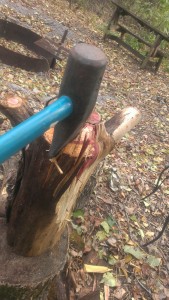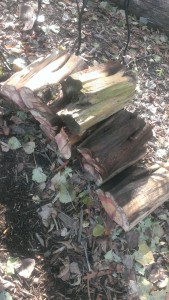Fall Samhain Moon
Each day has its lessons. Today the Latin was harder than yesterday or the day before and I had to spend time in the grammar book reminding myself about supines and gerundives. On top of that I still couldn’t wrestle a sentence out of the two verses that troubled me.
When I’d run my brain as far as I could down the old Latin way, it was a good time to go  outside and split wood for the Samhain bonfire. Boy, it had been awhile since I split wood.
outside and split wood for the Samhain bonfire. Boy, it had been awhile since I split wood.
The splitting maul combines a dull axe and a sledge hammer. When you’re splitting wood you want to force the fibers apart, not cut them, as a sharpened felling or limbing ax will do. That results in ax blades sunk deep into the log.
Besides, as often happens, the splitting maul wedges itself in the wood, allowing for a secondary maneuver which involves lifting maul and with it the log into the air, then bringing both down on whatever solid surface you’re working with, in this case a chunk of the elm formerly in the vegetable garden. The more slender handle of a felling ax is not designed for the force generated by this action. The splitting maul, however, has a plastic handle that absorbs the blow and keeps right on working.
Here’s the completed work, which consists of two cedar trees blown over by a windstorm a couple of years ago. They used to be beyond our deck, between us and the vegetable garden. I still miss them. Well, this is actually about half of it, but you get the point of what splitting accomplishes. It creates a surface that more easily catches fire; and, if it were an issue, which it isn’t, makes them easier to put in a fireplace or stove.
couple of years ago. They used to be beyond our deck, between us and the vegetable garden. I still miss them. Well, this is actually about half of it, but you get the point of what splitting accomplishes. It creates a surface that more easily catches fire; and, if it were an issue, which it isn’t, makes them easier to put in a fireplace or stove.
Anyhow, after lifting the maul and the occasional log in the air and slamming them back down on the elm, I was glad I do regular resistance work.
